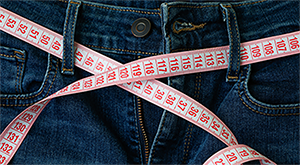The Ultimate Guide to Body Fat Percentage

It isn’t possible to gain an overall view of your health and wellbeing from standing on a scale, comparing data, or using a skinfold calliper as true health relies on your personal relationship with your body and mind.
However, calculations such as weight, body fat percentage, and body mass index can all be used to gain a better understanding of a person’s physical health.
These measurements have created a standard of health for medical professionals to refer to.
In this ultimate guide, we’ll take a more detailed look at Body fat percentages, what it means, healthy ranges for men and women, and how to calculate it.
What Is Body Fat Percentage?
Body fat percentage used to determine how much of a person’s total body weight consists of body fat. Essentially, it is an indication of a person’s total fat mass in their body compared to any of your organs, bones, muscles, tendons, hopes and dreams.
Body fat percentage is the total mass of fat divided by your total body mass. While many people who want to lose weight will be focused on losing body fat, it’s good to bear in mind that your body fat percentage does include essential body fat required to keep organs working as they should, and storage body fat.
In terms of the ideal body fat percentage, there are percentage ranges that are considered healthy, but it is important to remember that these vary for men and women.
Your ideal body fat percentage can also depend on if you are training your body for a particular sport, for example, male bodybuilders with a large amount of muscle mass will be aiming for a very low BFP of around 5-8%, or potentially lower during competition time. In contrast, a male marathon athlete may have a similar BFP between 5-11% and physically look very different.
What Methods Are There for Calculating Body Fat Percentage?
There are a number of methods for calculating body fat percentage. These can include more hi-tech options such as using dual-energy X-ray absorptiometry (DXA), air displacement plethysmography (Bod Pod), 3-D body scanners and hydrostatic weighing.
It is also possible to calculate body fat percentage using skinfold calipers for an accurate result. They work by pinching different areas of the skin and then converting the measurements. Women should measure at the triceps, an inch above the hip bone, and thigh. Men should measure the fat at the chest, abdominals and thigh.
For a simple measure of body fat percentage using only a tape measure, men should measure neck circumference and the largest part of the abdomen. Then subtract the neck value from the abdomen value to calculate the circumference value and then your estimated body fat percentage.
At Marsden, we offer a range of bioelectrical impedance scales that can make a number of calculations, including body fat percentage. These scales work by measuring the speed of electrical impulses running through your body and then estimating the amount of water vs fat.
Healthy Body Fat Percentage Range for Men
In terms of a healthy range of body fat percentage for men, it can depend on your ideal physique and whether or not you are an athlete. However, generally 14-17% BFP is a fit, and healthy range, although 18-25% is considered acceptable. Male athletes, depending on the sport, usually have between 6 and 13% BFP.
2-4% BFP is considered essential fat for a male meaning this is the minimum amount of fat mass required for survival as fat protects internal organs and stores energy. A body fat percentage of 26% + is considered obese for a male.
Healthy Body Fat Percentage Range for Women
An ideal, healthy range of body fat percentage can also differ for women, who generally require more body fat than men. 21-24% BFP is considered to be the fitness range, although any body fat percentage between 25 and 31% is healthy and acceptable. Female athletes typically have a BFP of 14-20%.
10-12% BFP is considered essential fat for women, and any measurement around this range could be dangerous, and anything less could result in organ failure. A body fat percentage of 32%+ is considered obese for a female.
Download our free body fat percentage chart
Finding out your body fat percentage is useful for two things: knowing how healthy your body is, and determining whether your weight goals are realistic.
The Marsden Body Fat Percentage Chart splits body fat percentages by men and women. The percentage of essential fat in men is 3-5%, and for women it’s 8-12%.
The A3-sized chart will automatically open - you can then right-click to save to your computer, and print out.
Further Reading
If you have a high body fat percentage, but a low muscle mass, you may be at risk of being skinny fat. Find out what the term skinny fat means and how to tell if you're skinny fat in this blog post.
Want to know more about the ideal BFP? Take a look at this blog post that compares the typical body fat percentage of different athletes.
Have you received your body composition results, but have no idea what they mean? Find out what every reading on a body composition scale means and their healthy ranges.